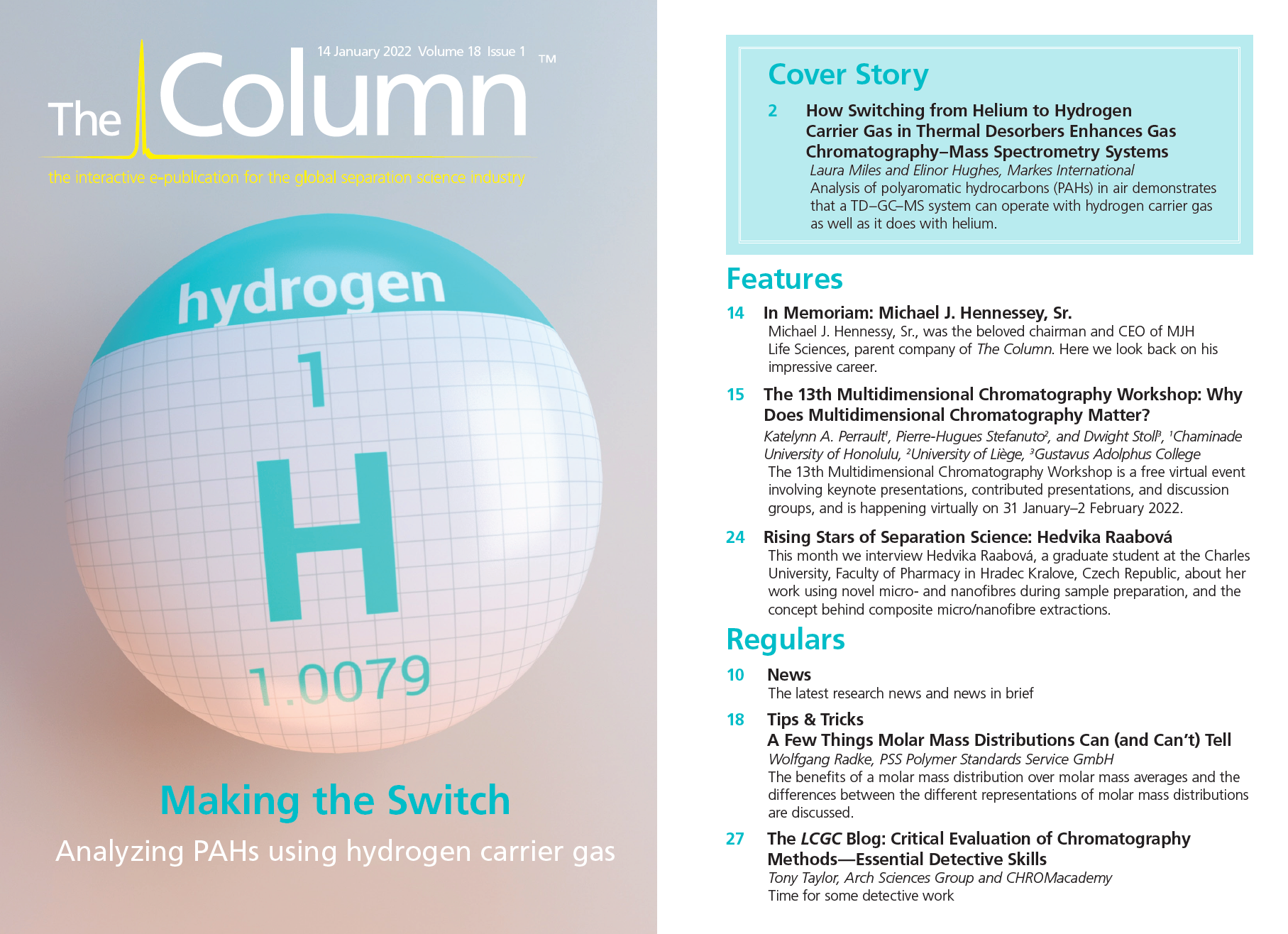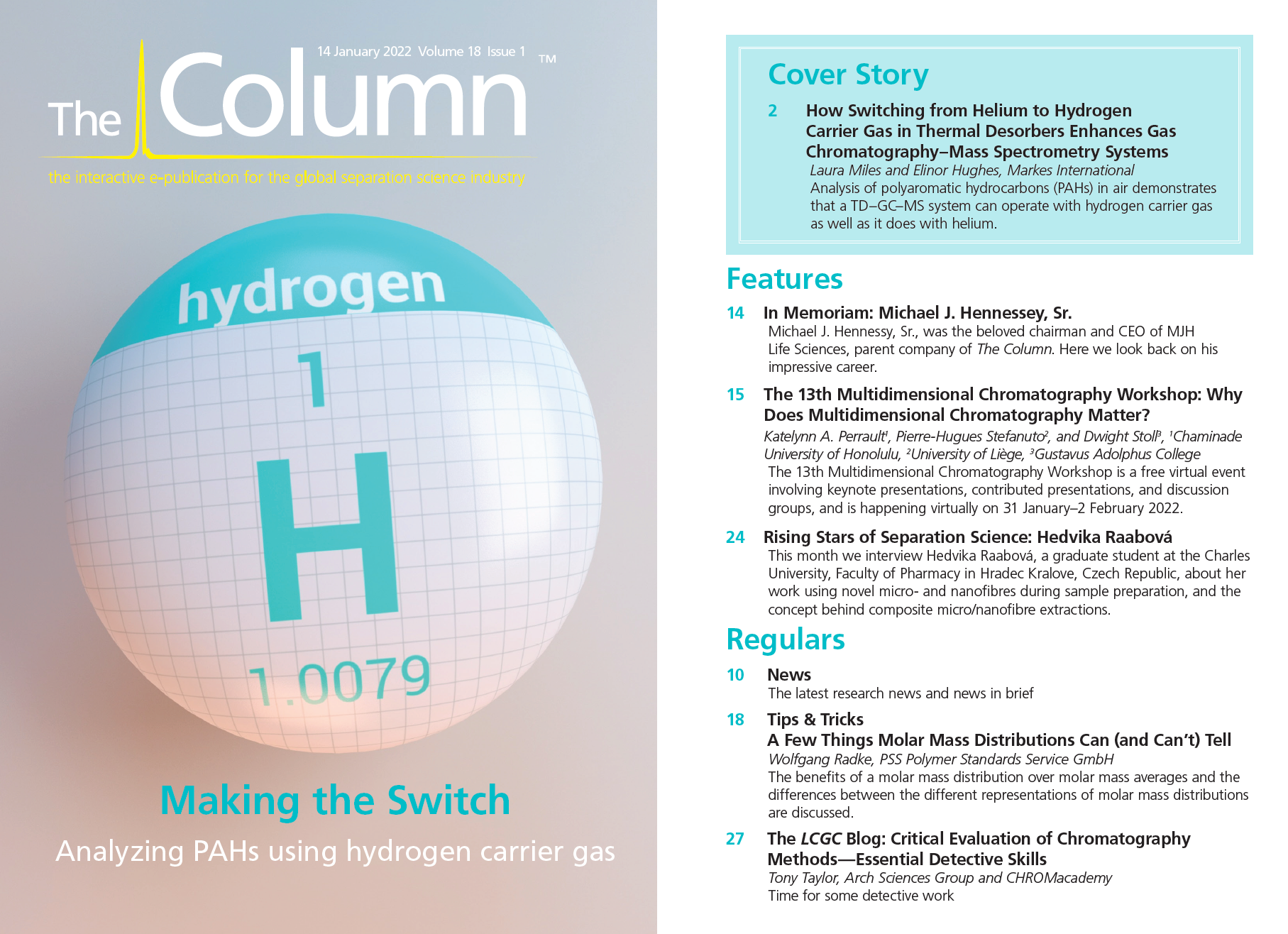Rising Stars of Separation Science: Hedvika Raabová
This month we interview Hedvika Raabová, a graduate student at the Charles University, Faculty of Pharmacy in Hradec Kralove, Czech Republic, about her work using novel micro- and nanofibres during sample preparation, and the concept behind composite micro-/nanofibre extractions.
Q. When did you first encounter chromatography and what attracted you to the subject?
A: The first time I came across a chromatographic instrument was when I was working on my master thesis five years ago. At that time, it was mostly a “black box” where I inserted my samples in one end and the results came out the other. It was only during my graduate studies that I began to learn more about this separation technique. This understanding resulted from the topic of my Ph.D. thesis where liquid chromatography (LC) played an important role. Thus, I cannot tell for sure when I genuinely chose to work in this field of separation sciences, but I definitely do not regret it. I realized very quickly how flexible liquid chromatography can be depending on which approach is chosen. The repetitive, large-scale analyses can be done quickly and precisely. One just needs to place the samples in the instrument and push the start button. Or one can be more creative and try different mobile and stationary phases, add more columns, use various detectors, and thus move the work to the next level.
Q. Can you tell us more about your Ph.D. thesis?
A: My thesis dealt with the application of nanofibrous polymers as innovative sorbents for solid-phase extraction (SPE) coupled online with LC. The various nanofibrous polymers were manually filled into an extraction cartridge and this extraction unit was introduced into the chromatographic system. Then, the extraction and chromatographic analysis was performed and the extraction efficiency of the sorbents was evaluated from the peak areas. My Ph.D. thesis summarized all the theoretical and practical aspects of this topic. It included a description of sorbent fabrication procedures, modifications of the sorbent, and the comparison of the effectiveness of the polymer sorbents for different analytes. I described the challenges of the preparation of the extraction unit and discussed the pros and cons of nanofibrous extraction sorbents.
Q. What chromatographic techniques have you worked with?
A:I have to say, I am pretty conservative about the techniques I use. In my research I work mostly with high performance liquid chromatography (HPLC) or ultrahigh‑pressure liquid chromatography (UHPLC) systems and reversed-phase separation mechanism. Depending on the project, I use them in one‑dimensional or two-dimensional mode.
Q. Your primary focus concerns the use of novel micro- and nanofibres in sample preparation prior to separation via chromatography—what specifically attracted you to this area of research?
A: My current scientific focus was again more a lucky coincidence than a conscious decision. Since I have always enjoyed working in the laboratory, I wanted to complete my master thesis in the Department of Analytical Chemistry. The original task was just a simple analyte determination via HPLC. But at the same time, the initial experiments with nanofibres started in the department and my supervisor asked me to be part of the team. No one knew at that time if and how the extraction using nanofibres would work. This sparkle of uncertainty attracted me much more than the previous “safe” project and I started using nanofibres for the solid-phase extraction. First, the extractions proceeded separately, and the extracts were analyzed by LC to evaluate the extraction efficiency of the polymer fibres. The results were very promising, and it began to be clear to me that I would like to explore this topic a bit deeper. Therefore, I continued as a Ph.D. student.
Q. You have recently published a paper on polycaprolactone composite micro- and nanofibre material as an alternative to restricted access media (RAM) for extraction and separation of non-steroidal anti-inflammatory drugs from human serum (1). Could you tell us about this research? What do these novel polymer fibres offer over others available?
A: After all the elementary research with nanofibrous sorbents I had undertaken, I was curious to find some practical application. I finally had this opportunity when we confirmed that the composite micro/nanofibres extracted the analytes from cow milk and human serum with minimal prior treatment of those matrices. The analytes I chose were the non‑steroidal anti‑inflammatory drugs because they are common medication. It was also easy to obtain real-life samples from the local hospital. They are also administered in tens or even hundreds of milligrams doses, so the UV detector we used was sensitive enough to aid in detection. In the end, we had a method for online extraction of ibuprofen, ketoprofen, naproxen, and diclofenac from human serum that was used for diclofenac determination in a real-life serum sample. There is still a long way to go, but I feel that the nanofibrous sorbents are a bit closer to common application in analytical laboratories after publication of this study. We achieved great results with the composite micro/nanofibres that were comparable to the silica sorbents. Unlike purely nanofibrous sorbents, the composites have better mechanical stability and are therefore suitable for online extractions in high-pressure systems.
Q. Can you talk about the concept behind composite micro/nanofibre extractions?
A: As I mentioned before, the greatest advantage of this composite material is its mechanical stability. When we started using nanofibres for online extraction, it was hard to achieve a repeatable result as the sorbents could not withstand the high back pressure. The fibres collapsed in the extraction unit, leading to increase of the void volumes, and the extraction did not work well. We solved the problem by combining the nano- and microfibres in the sorbent. The technology for production of these fibres was invented at the Technical University in Liberec (Czech Republic) with which we cooperate. The composite micro/nanofibrous material combines the mechanical stability of microfibres and the enhanced surface area of nanofibres. These benefits significantly improved the results of our experiments.
Q. What application areas could these novel polymer fibre materials be useful for?
A: This is a tricky question, and it would probably cost me another four years of research to demonstrate other application areas, even just for analytical chemistry and separation sciences alone. But as far as I know, these composite materials are applied in tissue engineering, and I believe that they can also be used as a filtration material in the industrial sector.
Q. Are there any challenges involved with using these novel materials for sample preparation?
A: Of course there are, and as our research progresses new ones are emerging all the time. However, I think the most crucial issues concerning the preparation of extraction cartridges have already been overcome, for example, cartridge leaking, fluctuation of mobile phase flow and back pressure, sorbent dissolution. Now, we continue working
on improvements in extraction efficiency and selectivity. Overall, in my opinion, dealing with the challenges is an inseparable part of the scientific research. If no challenges were left, it would be the end of the research.
Q. Anything else you would like to add?
A: I would like to point out that the nanofibrous sorbents should not be compared entirely with the commercial ones. The extraction using nanofibres has its own specifics, with some being beneficial while others are not. One day the fibrous sorbents may become an interesting alternative to the commercial products, but I do not think they can replace them completely.
Q. What are the emerging trends in sample preparation?
A: Sample preparation follows the global trend to do things better and faster. The trends are for miniaturized formats for sample pretreatment devices, which naturally results in the need for new sorbents. They must be very selective and provide a high extraction capacity as sample volumes decrease and so do the sorbent amounts. Scientists have already found many ways to achieve the desired sorbent properties, but the search for new materials is still ongoing. In addition, more sustainable approaches are becoming more and more valued in sample preparation. A reusability of nanofibrous sorbents and a biodegradability option for some of them support this trend.
Q. What projects are you working on next?
A: Actually, I also want to follow the trends in sample preparation and achieve more selective extractions using nanofibres. One idea is to link the specific antibodies on the fibre surface and proceed with the analyte extraction based on antigen-antibody interaction. I have not yet started because I have been busy with my Ph.D. thesis until now. Anyway, I want to give my full attention to this project at the beginning of 2022 and see how it goes.
Reference
- H. Raabová, L. Chocholoušová Havlíková, J. Erben, J. Chvojka, F Švec, and D. Šatínský, Nanomaterials 11(10), 2669 (2021).

Hedvika Raabová is a graduate student at the Charles University, Faculty of Pharmacy in Hradec Kralove, Czech Republic, where she also received her first degree in pharmacy in 2017. She has always been enthusiastic about the work in the laboratory and therefore chose to continue with her PhD studies at the Department of Analytical Chemistry. She became a member of Dalibor Satinsky’s research group, which are focused on the application of nanofibres for solid-phase extraction. This move was the beginning of her scientific journey in the separation sciences, and has led her mostly to liquid chromatography, with a small detour to a stay in a Swiss laboratory where she worked with capillary electrophoresis. With the same passion she has for the laboratory, she devotes herself to dancing, baking, and book reading.

Common Challenges in Nitrosamine Analysis: An LCGC International Peer Exchange
April 15th 2025A recent roundtable discussion featuring Aloka Srinivasan of Raaha, Mayank Bhanti of the United States Pharmacopeia (USP), and Amber Burch of Purisys discussed the challenges surrounding nitrosamine analysis in pharmaceuticals.
Silvia Radenkovic on Building Connections in the Scientific Community
April 11th 2025In the second part of our conversation with Silvia Radenkovic, she shares insights into her involvement in scientific organizations and offers advice for young scientists looking to engage more in scientific organizations.

.png&w=3840&q=75)

.png&w=3840&q=75)



.png&w=3840&q=75)



.png&w=3840&q=75)












